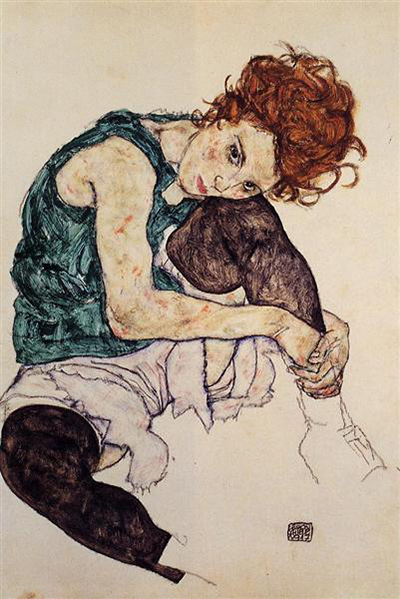Seated Woman, also known as Sitting Woman with Legs Drawn Up is a portrait of Egon's wife, Edith, from 1917. Schiele would produce portraits of her right up to her death, in oils, watercolours and pen and ink.
Green and orange tones create an eye catching contrast which gives this painting real impact. The setting for this portrait feels relatively relaxed and personal to the artist, offering us a view of his home life. Edith sits on the floor, resting casually. Egon produced several portraits in these types of relaxed poses during this time. The original Sitting Woman with Legs Drawn Up painting by Egon Schiele is on display at the Narodni Galeri. Artist Schiele produced a wealth of erotic art in his career but in this example chose to fully dress his wife. It is likely that persistent interference around his work may have caused this - he was, for instance, arrested several times on charges of lude artwork. It is unfortunate that any artist will be impeded in this way but Schiele did not help himself by surrounding himself with models who were often fairly young, in their late teens, which certainly started rumours about his private life.
Schiele was a highly skilled sketcher who would initially draw out the forms of his portrait models, before then later adding colour to complete the piece. In this case he chooses to add more variety of palette than he normally would, adding a black tone plus also blue, green and orange. He actually seemed to be attracted to auburn hair, as Wally famously also had this tone too. Here his wife looks directly at him with a confident gaze, whilst sat on the floor with her head resting on her left knee. The artist liked to contort his models into all manner of strange angles and would rarely resort to more traditional styles of portrait layouts. This was one example of how his style was entirely contemporary and it helped to inspire many other within the first half of the 20th century.
The artist would specialise in two main genres within his career, namely portraiture and also landscapes. He enjoyed free train travel in his local area and so could not resist visiting different towns and cities close to where he lived, bringing all manner of different inspirations into his career. These helped to bring about Expressionist landscape painting, as he applied his own emotions to the scenes in front of him. The same can be said for his portraits too, as well as his highly personal self-portraits, which also numbered a plenty by the end of his career. All in all, this was a highly skilled creative individual who perhaps had even more to offer were it not for his life to be cut short in his late twenties as a result of the Europe-wide spread of Spanish Flu.




